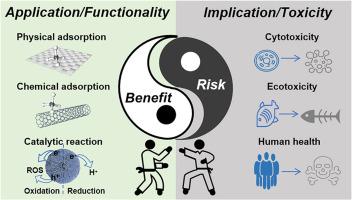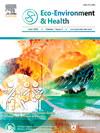Let the two sides of the same coin meet—Environmental health and safety-oriented development of functional nanomaterials for environmental remediations
IF 17.6
引用次数: 0
Abstract
Nanotechnology and engineered nanomaterials have been at the forefront of technological breakthroughs of the 21st century. With the challenges of increasingly complex and emergent environmental pollution, nanotechnology offers exciting complementary approaches to achieve high efficiencies with low or green energy input. However, unknown and unintended hazardous effects and health risks associated with nanotechnology hinder its full-scale implementation. Therefore, the development of safer nanomaterials lies in the critical balance between the applications and implications of nanomaterials. To facilitate constructive dialogue between the two sides (i.e., applications and implications) of the same coin, this review sets forth to summarize the current progress of the environmental applications of nanomaterials and establish the structure–property-functionality relationship. A systematic analysis of the structure–property-toxicity relationship is also provided to advocate the Safe and Sustainable-by-Design strategy for nanomaterials. Lastly, the review also discusses the future of artificial intelligence-assisted environmental health and safety-oriented development of nanomaterials.

让硬币的两面相遇--以环境健康和安全为导向开发用于环境修复的功能纳米材料
纳米技术和工程纳米材料一直是 21 世纪技术突破的前沿。面对日益复杂和新出现的环境污染挑战,纳米技术提供了令人兴奋的补充方法,以低能耗或绿色能源投入实现高效率。然而,与纳米技术相关的未知和意外的有害影响和健康风险阻碍了纳米技术的全面实施。因此,开发更安全的纳米材料需要在纳米材料的应用和影响之间取得关键的平衡。为了促进纳米材料应用和影响这两个方面的建设性对话,本综述总结了当前纳米材料在环境应用方面的进展,并建立了结构-性能-功能关系。此外,还对结构-性能-毒性关系进行了系统分析,以倡导纳米材料的安全和可持续设计战略。最后,该综述还讨论了人工智能辅助环境健康和以安全为导向的纳米材料开发的未来。
本文章由计算机程序翻译,如有差异,请以英文原文为准。
求助全文
约1分钟内获得全文
求助全文
来源期刊

Eco-Environment & Health
环境科学与生态学-生态、环境与健康
CiteScore
11.00
自引率
0.00%
发文量
18
审稿时长
22 days
期刊介绍:
Eco-Environment & Health (EEH) is an international and multidisciplinary peer-reviewed journal designed for publications on the frontiers of the ecology, environment and health as well as their related disciplines. EEH focuses on the concept of “One Health” to promote green and sustainable development, dealing with the interactions among ecology, environment and health, and the underlying mechanisms and interventions. Our mission is to be one of the most important flagship journals in the field of environmental health.
Scopes
EEH covers a variety of research areas, including but not limited to ecology and biodiversity conservation, environmental behaviors and bioprocesses of emerging contaminants, human exposure and health effects, and evaluation, management and regulation of environmental risks. The key topics of EEH include:
1) Ecology and Biodiversity Conservation
Biodiversity
Ecological restoration
Ecological safety
Protected area
2) Environmental and Biological Fate of Emerging Contaminants
Environmental behaviors
Environmental processes
Environmental microbiology
3) Human Exposure and Health Effects
Environmental toxicology
Environmental epidemiology
Environmental health risk
Food safety
4) Evaluation, Management and Regulation of Environmental Risks
Chemical safety
Environmental policy
Health policy
Health economics
Environmental remediation
 求助内容:
求助内容: 应助结果提醒方式:
应助结果提醒方式:


